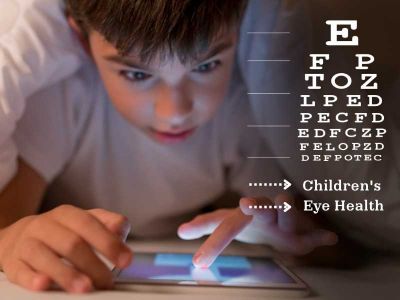Aug 24th, 2022
August is Children's Eye Health and Safety Month! We want to bring useful information at your fingertips (and your screens) that can help you protect your child's developing vision, just as you take care of the rest of their body's health.
Did you know?
As children grow, careful attention to a child's eye health can help catch problems early, while their eyes are still developing.
- By 3 months, a baby's eyes should focus and follow objects
- By 5 months, a baby sees in three dimensions
- By 9 months, a baby's eyes have nearly turned their final color
- At 3-4 years old, there is enhanced hand-eye coordination and fine motor skills
- At 4-6 years old, there is letter and object recognition as well as improved convergence that helps a child follow words from left to right across a page
- School-aged children with good screen time hygiene may lower their risk of myopia and digital eye strain
- School-aged children with poor vision, focusing problems, jerky eye movements, or crossed eyes do cause learning disabilities (learning disabilities are caused by problems with how the brain processes what it sees or hears, not by faulty eyes)
- Teens and young adults may struggle with proper contact lens care, which can put them at higher risk for eye infections that can cause impaired vision or blindness.
- Want to know more about childhood vision development? See 20 Things to Know About Children's Vision.
Good vision is key to a child’s physical development, success in school, and overall well-being.
Screening or exams
Although both are important, a vision screening and an eye exam are not the same thing.
Vision screening is a quick evaluation of your child’s eyes and can be done by a family doctor, pediatrician, school nurse, or other health care professional.
Comprehensive eye exams diagnose eye disease and is done by an eye doctor (ophthalmologist or optometrist).
A vision screening should not take the place of a comprehensive eye exam. The American Academy of Ophthalmology advises parents to seek a comprehensive eye exam if:
- their child fails a vision screening
- vision screening is inconclusive or cannot be done
- referred by a pediatrician or school nurse
- their child has a vision complaint or observed abnormal visual behavior, or is at risk for developing eye problems
- their child has a learning disability, developmental delay, neuropsychological condition or behavioral issue.
To see a recommended schedule for child vision screenings, click here.
Signs to look for
Symptoms of eye problems in children can sometimes be obvious and other times be subtle. It’s important to detect and treat issues early, while vision is still developing. Regular screenings that can help protect your child’s vision as they grow and eye exams at every age and life stage can help keep their vision strong.
These are common problems that should not go ignored:
- RSVP (Redness, Sensitivity to light, Vision change, Pain)
- Blinking or rubbing of the eyes
- Spots on the white of the eye (check the color and size of the spot)
- Dilated eyes/large pupils
- Seeing spots in vision
- Discomfort or itchiness
- Sleeping with eyes open
- Crust or goop in eyes
- Misaligned eyes (when one eye turns inward, outward, upward or downward)
- Head tilting or covering one eye
Other signs that could point to vision problems include:
- Having a short attention span (if your child seems quick to lose interest in games, projects, or lengthy activities)
- Losing their place when reading (if your child has difficulty seeing to keep track of where they are on a page)
- Avoiding reading and other close activities (if your child avoids activities that require up-close focus)
- Turning their head to the side (if your child turns their head when looking at something in front of them to help them see better)
Tips for your child's eye safety
Your child’s vision health affects how well they can see, learn, and enjoy life. Here are some tips to protect their eyes and their developing vision.
- Eat well – fruits and vegetables have many vitamins and minerals necessary to maintain healthy eyes and vision
- Limit screen time – taking frequent breaks is also a good habit to have when doing other kinds of near-vision activities, such as reading, writing, or drawing
- Get enough sleep – not getting enough sleep can affect how well your child’s eyes heal from everyday eye strain and irritants in the environment
- Spend time outdoors – going outdoors allows eyes to look at objects in the distance, which gives eyes a chance to recover from eye strain and fatigue
- Wear sunglasses – exposure to the sun’s ultraviolet (UV) rays over time can be harmful to the eyes
- Use protective eyewear – about 90% of eye injuries can be prevented with protective eyewear (e.g. in sports)
- Get regular eye exams – if anything changes, the doctor will be able to treat and manage your child’s vision quickly
In the United States, about 1 in 4 preschool-aged children have an undiagnosed or untreated vision problem. The Cape Girardeau County Public Health Center joins the celebration of Children's Eye Health and Safety Month by spreading awareness and encouraging all parents to make eye screenings and eye exams a regular part of their children's health care.
Source: Centers for Disease Control and Prevention (CDC), American Academy of Ophthalmology (AAO)

